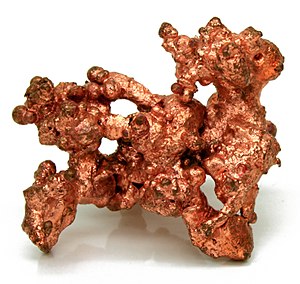From English Wikipedia @ Freddythechick
Chemical element with atomic number 29 (Cu)
Copper, 29 Cu Appearance Red-orange metallic luster
Atomic number (Z ) 29 Group group 11 Period period 4 Block d-block Electron configuration [Ar ] 3d10 4s1 Electrons per shell 2, 8, 18, 1 Phase at STP solid Melting point 1357.77 K (1084.62 °C, 1984.32 °F) Boiling point 2835 K (2562 °C, 4643 °F) Density (at 20° C) 8.935 g/cm3 [3] when liquid (at m.p. ) 8.02 g/cm3 Heat of fusion 13.26 kJ/mol Heat of vaporization 300.4 kJ/mol Molar heat capacity 24.440 J/(mol·K) Vapor pressure
P (Pa)
1
10
100
1 k
10 k
100 k
at T (K)
1509
1661
1850
2089
2404
2834
Oxidation states −2, 0,[4] +1 +2 basic oxide) Electronegativity Pauling scale: 1.90 Ionization energies 1st: 745.5 kJ/mol 2nd: 1957.9 kJ/mol 3rd: 3555 kJ/mol (more ) Atomic radius empirical: 128 pm Covalent radius 132±4 pm Van der Waals radius 140 pm Spectral lines of copperNatural occurrence primordial Crystal structure face-centered cubic (fcc) (cF4 ) Lattice constant a = 361.50 pm (at 20 °C)[3] Thermal expansion × 10−6 [3] Thermal conductivity 401 W/(m⋅K) Electrical resistivity 16.78 nΩ⋅m (at 20 °C) Magnetic ordering diamagnetic [5] Molar magnetic susceptibility × 10−6 3 /mol[6] Young's modulus 110–128 GPa Shear modulus 48 GPa Bulk modulus 140 GPa Speed of sound thin rod (annealed)r.t. ) Poisson ratio 0.34 Mohs hardness 3.0 Vickers hardness 343–369 MPa Brinell hardness 235–878 MPa CAS Number 7440-50-8 Naming after Cyprus , principal mining place in Roman era (Cyprium Discovery Middle East (9000 BC ) Symbol "Cu": from Latin cuprum
Category: Copper references
child table, as reused in {IB-Cu}
References These references will appear in the article, but this list appears only on this page.
^ "Standard Atomic Weights: Copper" . CIAAW . 1969.^ Prohaska, Thomas; Irrgeher, Johanna; Benefield, Jacqueline; Böhlke, John K.; Chesson, Lesley A.; Coplen, Tyler B.; Ding, Tiping; Dunn, Philip J. H.; Gröning, Manfred; Holden, Norman E.; Meijer, Harro A. J. (2022-05-04). "Standard atomic weights of the elements 2021 (IUPAC Technical Report)" . Pure and Applied Chemistry . doi :10.1515/pac-2019-0603 . ISSN 1365-3075 . ^ 3.0 3.1 3.2 Arblaster, John W. (2018). Selected Values of the Crystallographic Properties of Elements . Materials Park, Ohio: ASM International. ISBN 978-1-62708-155-9 ^ Moret, Marc-Etienne; Zhang, Limei; Peters, Jonas C. (2013). "A Polar Copper–Boron One-Electron σ-Bond" . J. Am. Chem. Soc . 135 (10): 3792–3795. doi :10.1021/ja4006578 . PMID 23418750 . ^ Lide, D. R., ed. (2005). "Magnetic susceptibility of the elements and inorganic compounds". CRC Handbook of Chemistry and Physics (PDF) (86th ed.). Boca Raton (FL): CRC Press. ISBN 0-8493-0486-5 the original (PDF) on 2011-03-03. ^ Weast, Robert (1984). CRC, Handbook of Chemistry and Physics . Boca Raton, Florida: Chemical Rubber Company Publishing. pp. E110. ISBN 0-8493-0464-4 ^ 7.0 7.1 Kondev, F. G.; Wang, M.; Huang, W. J.; Naimi, S.; Audi, G. (2021). "The NUBASE2020 evaluation of nuclear properties" (PDF) . Chinese Physics C . 45 (3): 030001. doi :10.1088/1674-1137/abddae . Lua error in mw.title.lua at line 229: too many expensive function calls.


